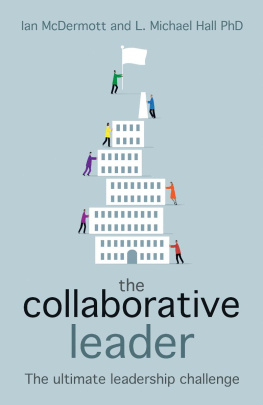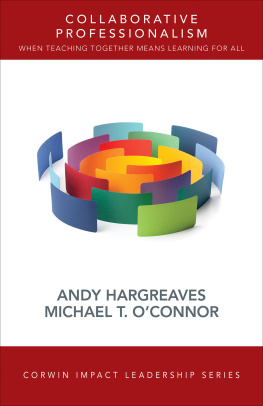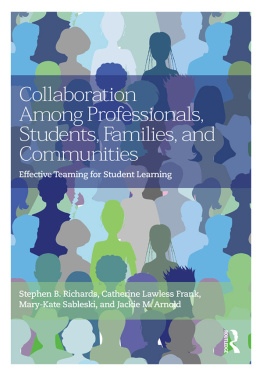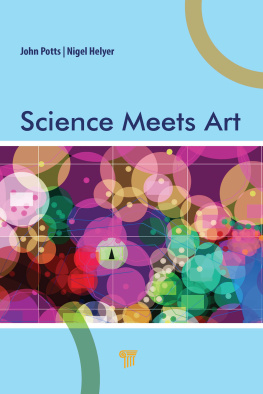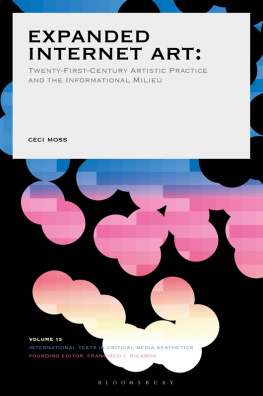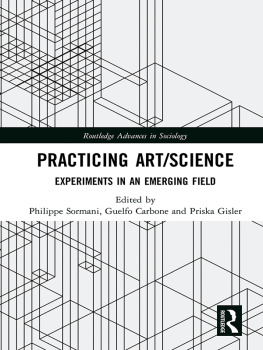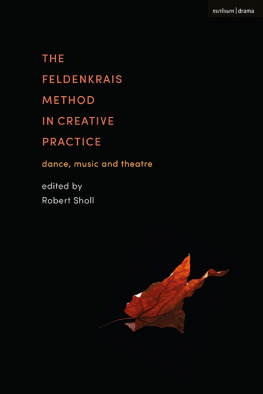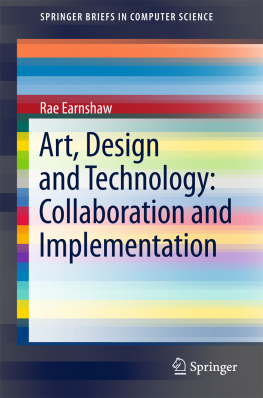Routledge Advances in Art and Visual Studies
1 Ethics and Images of Pain
Edited by Asbjrn Grnstad & Henrik Gustafsson
2 Meanings of Abstract Art
Between Nature and Theory
Edited by Paul Crowther and Isabel Wnsche
3 Genealogy and Ontology of the Western Image and its Digital Future
John Lechte
4 Representations of Pain in Art and Visual Culture
Edited by Maria Pia Di Bella and James Elkins
5 Mangas Cultural Crossroads
Edited by Jaqueline Berndt and Bettina Kmmerling-Meibauer
6 Mobility and Fantasy in Visual Culture
Edited by Lewis Johnson
7 Spiritual Art and Art Education
Janis Lander
8 Art in the Asia-Pacific
Intimate Publics
Edited by Larissa Hjorth, Natalie King, and Mami Kataoka
9 Performing Beauty in Participatory Art and Culture
Falk Heinrich
10 The Uses of Art in Public Space
Edited by Julia Lossau and Quentin Stevens
11 On Not Looking
The Paradox of Contemporary Visual Culture
Edited by Frances Guerin
12 Play and Participation in Contemporary Arts Practices
Tim Stott
13 Urbanization and Contemporary Chinese Art
Meiqin Wang
14 Photography and Place
Seeing and Not Seeing Germany After 1945
Donna West Brett
15 How Folklore Shaped Modern Art
A Post-Critical History of Aesthetics
Wes Hill
16 Installation Art and the Practices of Archivalism
David Houston Jones
17 Collaborative Art in the Twenty-First Century
Edited by Sondra Bacharach, Jeremy Neil Booth, and Siv B. Fjrestad
First published 2016
by Routledge
711 Third Avenue, New York, NY 10017
and by Routledge
2 Park Square, Milton Park, Abingdon, Oxon OX14 4RN
Routledge is an imprint of the Taylor & Francis Group, an informa business
2016 Taylor & Francis
The right of the editors to be identified as the authors of the editorial material, and of the authors for their individual chapters, has been asserted in accordance with sections 77 and 78 of the Copyright, Designs and Patents Act 1988.
All rights reserved. No part of this book may be reprinted or reproduced or utilised in any form or by any electronic, mechanical, or other means, now known or hereafter invented, including photocopying and recording, or in any information storage or retrieval system, without permission in writing from the publishers.
Trademark notice: Product or corporate names may be trademarks or registered trademarks, and are used only for identification and explanation without intent to infringe.
Library of Congress Cataloging-in-Publication Data
Names: Bacharach, Sondra, editor.
Title: Collaborative art in the twenty-first century / Edited by Sondra Bacharach, Jeremy Neil Booth and Siv B. Fjrestad.
Description: New York: Routledge, 2016. |
Series: Routledge advances in art and visual studies; 17 | Includes bibliographical references and index.
Identifiers: LCCN 2015050119
Subjects: LCSH: Art, Modern21st century. | Artistic collaboration. | Group work in art.
Classification: LCC N6497 .C65 2016 | DDC 709.04dc23
LC record available at http://lccn.loc.gov/2015050119
ISBN: 978-1-138-93574-7 (hbk)
ISBN: 978-1-315-67719-4 (ebk)
Typeset in Sabon
by codeMantra
This book is dedicated to Stephen and Samantha Eng, Florian and Felix Fjrestad-Jones, and Rafael Schroth: the five human babies who emerged, influenced (slowed down, fast-forwarded), and reflected our growing awareness of the profound and meaningful tangle of art, life, and technology in collaborative practice. It is also dedicated to the cultural and natural resources accessible to all members of a society, including air, water, gardens, information, open source software, and the internet. Long may these resources be held in common, not privately owned.
Contents
SONDRA BACHARACH, JEREMY NEIL BOOTH AND SIV B. FJRESTAD
SECTION I
Collaboration in the Age of Technological Innovation
GABRIEL MENOTTI
GEMMA ARGELLO MANRESA AND SONDRA BACHARACH
IZABEL GALLIERA
TIJEN TUNALI
SECTION II
Collaboration and the Identity Crisis
K. E. GOVER
TIM CORBALLIS
HENRY JOHN PRATT
LEGWORK (TIMOTHY MURRAY, TOBEY ALBRIGHT, AND EGLE OBCARSKAITE)
KATERINA REED-TSOCHA
SECTION III
Rethinking Collaborations
LOUISE R. MAYHEW
JENNY GILLAM AND EUGENE HANSEN
BARTRAM ONEILL
LEORA MALT Z-LECA
SHERRI IRVIN
PETER MURPHY
DANIELLA RAMOS BARROQUEIRO
Table
Figures
This book is the result of an extended collaboration between Sondra Bacharach at Victoria University of Wellingtons Philosophy Programme and artists and writers Siv Fjrestad and Jeremy Booth, at the time working together at Enjoy Public Art Gallery. Along the way, we benefited from generous funding from the Royal Society of New Zealand Marsden Fund (collaborating with Deborah Tollefsen of the University of Memphis), Victoria University of Wellington, Enjoy Public Art Gallery, the Public Art Project Fund, and Creative New Zealand. We also benefited intellectually from artist Gregory Sholette during his Artist-in-Residence at Enjoy Public Art Gallery, a selection of the 20 international artists, writers, and critics who collaborated to create the Wellington Collaboratorium: An Imaginary Archive in June 2010, and arts practitioners and scholars who participated in the related public seminar on the topic. We would also like to acknowledge the hard work and wonderful insights of our contributors, to thank philosophy student Chrissy Van Hulst for all her hard work, and to remember Katerina Reed-Tsocha, who passed before this book came to print.
Sondra Bacharach, Jeremy Neil Booth, Siv B. Fjrestad
Collaborative Art in the Twenty-First Century presents an international cross section of contemporary collaborative art practice. It explores what it means for artists to work together, here and now. What we find is an extraordinary richness and variety of significant, new trends that respond specifically to an increasingly dynamic climate. A sign of the times, collaboration today requires a strategic engagement across the arts, social media, networking and technological innovation, as well as economic, business, and community-based spheres. Collaboration has become as much a way of life as it has an essential artistic approach.
The central argument of this collection is that collaborative practice in the twenty-first century is profoundly new: collaboration used to be driven by financial and artistic interests. Not everyone had all the materials, skills, and background to engage in art-making, or specific projects, so they decided to work together. The solo artist couldnt always afford the equipment or the training. Collaborating was a practical and strategic response to pursuing new artistic and political objectives in art, or a necessary means to responding to a compromising position, where working alone significantly reduced your artistic potential.
But, the rise of technological innovations revolutionizes how artists work. The past decade has seen a boom of internet-based art, both in the form of production tools and as a malleable, non-regulated international arena through which artists operate independently from mainstream galleries and institutions. Perhaps most significant is the accelerated expansion and acclimatization to internet-based communication, file-sharing platforms and strategies, online networking, social media, gaming, and virtual worlds.
Next page

